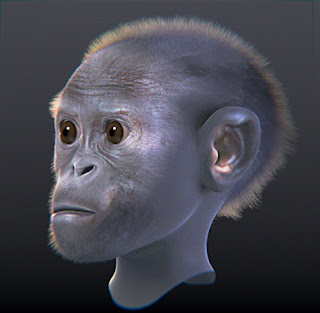As many of you know, since more than one year we are working on the exhibition "Facce. I molti volti della storia umana". Now that the exhibition was inaugurated and our work is completed, it is time to share with open licenses (CC-BY) what we produced.
It will be a long process, as the materials are different (images, photos, video, 3D models), nevertheless we have to start uploading the documents. Thanks to a short discussion with +Maurizio Napolitano (Fondazione Bruno Kessler) and +Rodrigo Padula (Grupo Wikimedia Brasileiro de Educação e Pesquisa), both expert in open data, I think that the best solution will be to upload the data directly in ATOR, where I can cite all the people who participated in the "production process", from 3D scan to facial reconstruction, till scientific validation.
IMHO the best image to start with is the one of the Taung Child, for different reason: it has been the first attempt performed by our team in order to reconstruct the face of an hominid; it summarizes our concept of Open Research; it has been one of the ideas that gave birth to exhibition "Facce", as Dr. Nicola Carrara conceived it; it is the first project in which Arc-Team, the Anthropological Museum of the University of Padua and Antrocom worked together; last but not least, it is a perfect example of what we mean of open data. Indeed the first reconstruction we produced (version 1.0), which actually is already part of the related article in Wikipedia, has been modified after the development (and the validation) of a new technique of paleo-art, based on the anatomical deformation of a CT scan of a Pan troglodytes. For this reason now we have a new and more accurate reconstruction, which can be considered a version 2.0 of the same model.
The open data we intend to share here in ATOR are meant to be open not only in the direction of free access for everyone, but also (most important) under the temporal dimension: they should just represent a step of a continuous evolution of the research, in which all the reconstructions can be considerate simply as the latest release of a model (exactly like in software development, with new versions and forks). For this reason we choose the Creative Commons Attribution license, in order to allow derived works and projects.
The two images below can explain better this concept: the first one represent the Taung Child reconstruction in his first version (based on an anatomical study of primates), while the second one is derived by the anatomical deformation of Pan troglodytes CT scan.
 |
| The first version of the reconstruction of the Taung Child |
 |
| The second version of the Taung Child |
Both of the models are the result of a team work, although most of the process (and in particular the most important and delicate phases) has been performed by the 3D artist +Cícero Moraes. Here below I want to cite the credits for this reconstruction (following the same order of the work-flow):
1. 3D scan of the cast: Luca Bezzi (Arc-Team) and +Moreno Tiziani (Antrocom)
2. 3D modeling (skull restoration, anatomical study, CT deformation): +Cícero Moraes (Arc-Team)
3. scientific validation: Prof. Telmo Pievani (University of Padua, Department of Biology) and Dott. Nicola Carrara(Anthropological Museum of the University of Padua)
Acknowledgement:
The Anthropological Museum of the University of Pauda, for providing the cast of the fossil.
The KUPRI, Primate Research Institute Kyoto University, for sharing the CT scans of different primates.
Dr. Claudio Paluani (University of Padua), who, during the lesson "Digital bones" at the Botanical Garden of the University of Padua, had the same idea we had about the validation of the methodology of anatomical deformation through the modification of two CT scans of living primates. This fact convinced us to perform the test, after seeing that more people reached the same conclusion about the validation problem.

No comments:
Post a Comment